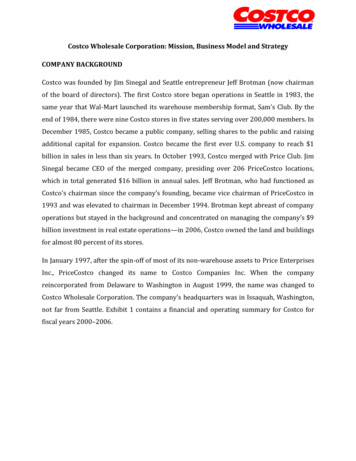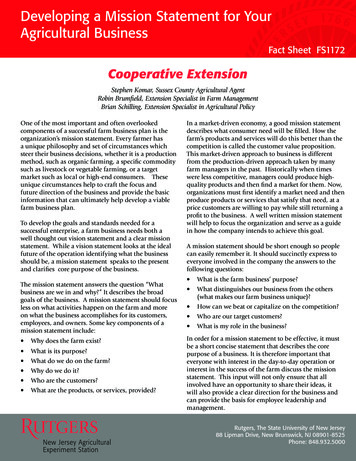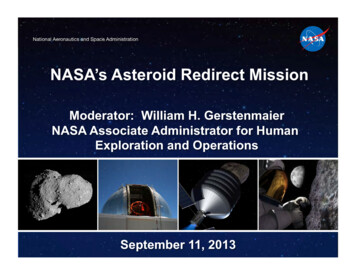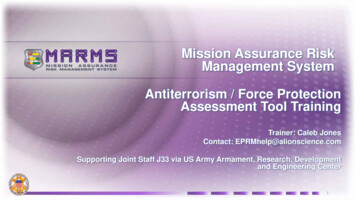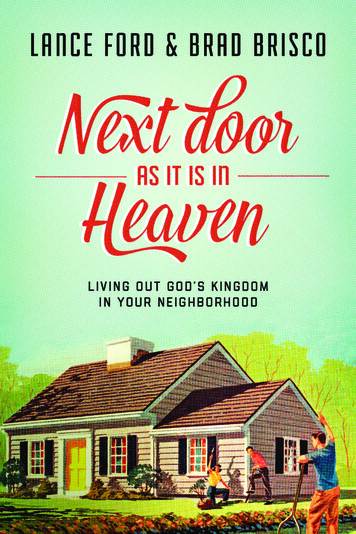
Transcription
When our understanding of mission is “somewhereelse,” the great commission feels out of reach. We’re leftwondering where we have to go to make a difference in theworld. We miss the fact that God sends us to the lives wealready have, to the places and spaces we regularly inhabit.What could it look like to see our ordinary lives throughthe fresh lenses of kingdom possibilities? In this engagingand practical resource, Ford and Brisco train us to live andlove like everyday missionaries in our here and now, thatwe might see God’s life and transformation next door as itis in heaven.JO SAXTONBoard chair of 3DMovements and author of More Than EnchantingLance and Brad are the real deal. They are truepractitioners, and this book is filled with their valuableknowledge and firsthand experiences. Next Door as It Isin Heaven is a must-read for anyone who is serious abouttaking the Great Commandment literally.DAVE RUNYONCoauthor of The Art of NeighboringWith all of Jesus’ teaching on the kingdom, why does itseem so far away and so difficult to understand? Next Dooras It Is in Heaven invites us to see the reality of the kingdombreaking out in our own neighborhoods and to followJesus’ invitation to join him there. It lays a very reasonedand biblical case for focusing relationally and locally on the
people around us. Having challenged us to live as neighborswho reflect the life of Christ, the authors do not leave usthere. Each chapter gives practical ideas on what we cando both individually and with others to bring the values ofthe kingdom to our neighborhoods. This is not a book oftechniques but a call to the abundant, loving kingdom lifethat is lived with the people next door.AL ENGLERMission director, NavNeighborsIn a culture where fear and scarcity have taken the day, thisis a timely call for a reorientation toward generosity andabundance. Seasoned with real-time stories, principles, andbiblical examples, this book is a both a starting block formissional observers and a map for those well on their wayto lives of incarnation. Next Door as It Is in Heaven is a callto emerge from our safe cocoons and step into possibilitiesright under our noses.ALAN BRIGGSChurch-planting catalyst and author of Staying Is the New GoingModern suburban life can offer privacy and self-sufficiency,but at the cost of loneliness, isolation, and relational poverty.Next Door as It Is in Heaven is a warm invitation to createthe margin and the practices that foster God’s dream forour local neighborhoods. Lance Ford and Brad Briscobring a wealth of sociological analysis, biblical inspiration,community development principles, and stories of best
practices to the question of how to foster good news inour own streets and local neighborhoods. They offerinvaluable wisdom for any Christian or local church thatis serious about neighborhood transformation rather thanjust tinkering with Sunday worship. Bring on a new era ofliving and serving locally!DARREN CRONSHAWMission catalyst, Baptist Union of Victoria; and professor of missionalleadership, Australian College of Ministries
as it is inLIVING OUT GOD’S KINGDOMIN YOUR NEIGHBORHOODLANCE FORD & BRAD BRISCOA NavPress resource published in alliancewith Tyndale House Publishers, Inc.
NavPress is the publishing ministry of The Navigators, an internationalChristian organization and leader in personal spiritual development.NavPress is committed to helping people grow spiritually and enjoy livesof meaning and hope through personal and group resources that arebiblically rooted, culturally relevant, and highly practical.For more information, visit www.NavPress.com.Next Door as It Is in Heaven: Living Out God’s Kingdom in Your NeighborhoodCopyright 2016 by Lance Ford and Brad Brisco. All rights reserved.A NavPress resource published in alliance with Tyndale House Publishers, Inc.NAVPRESS and the NAVPRESS logo are registered trademarks of NavPress, The Navigators,Colorado Springs, CO. TYNDALE is a registered trademark of Tyndale House Publishers, Inc.Absence of in connection with marks of NavPress or other parties does not indicate an absence ofregistration of those marks.The Team:Don Pape, Publisher; David Zimmerman, Acquiring Editor; Dan Farrell, DesignerCover illustration copyright CSA Images/Color Printstock Collection/Getty Images. All rightsreserved.Published in association with the literary agency of Mark Sweeney & Associates.All Scripture quotations, unless otherwise indicated, are taken from the Holy Bible, New InternationalVersion, NIV. Copyright 1973, 1978, 1984, 2011 by Biblica, Inc. Used by permission. Allrights reserved worldwide.Scripture quotations marked ESV are taken from The Holy Bible, English Standard Version (ESV ),copyright 2001 by Crossway, a publishing ministry of Good News Publishers. Used by permission.All rights reserved.Scripture quotations marked MSG are taken from THE MESSAGE by Eugene H. Peterson, copyright 1993, 1994, 1995, 1996, 2000, 2001, 2002. Used by permission of NavPress Publishing Group.All rights reserved.Scripture quotations marked NLT are taken from the Holy Bible, New Living Translation, copyright 1996, 2004, 2015 by Tyndale House Foundation. Used by permission of Tyndale HousePublishers, Inc., Carol Stream, Illinois 60188. All rights reserved.Some of the anecdotal illustrations in this book are true to life and are included with the permissionof the persons involved. All other illustrations are composites of real situations, and any resemblanceto people living or dead is coincidental.Library of Congress Cataloging-in-Publication DataNames: Ford, Lance, date, author.Title: Next door as it is in heaven : living out God's kingdom in your neighborhood / Lance Ford andBrad Brisco.Description: Colorado Springs : NavPress, 2016. Includes bibliographical references. Descriptionbased on print version record and CIP data provided by publisher; resource not viewed.Identifiers: LCCN 2016017887 (print) LCCN 2016015618 (ebook) ISBN 9781631465000(Apple) ISBN 9781631464980 (E-Pub) ISBN 9781631464997 (Kindle) ISBN 9781631464973Subjects: LCSH: Communities—Religious aspects—Christianity. Neighborhoods.Classification: LCC BV4517.5 (print) LCC BV4517.5 .F67 2016 (ebook) DDC 248.4—dc23LC record available at https://lccn.loc.gov/2016017887Printed in the United States of America227216205194183172161
ContentsI N T R O D U C T I O N There Goes the Neighborhood xi1 . P L A C E M AT T E R S The Priority of Incarnational Presence 12. THE REAL NEIGHBOR Open Hearts, Open Doors 193 . YO U R C O M M U N I T Y B A N K Realizing Our Resources and Possibilities 354. HERE COMES THE NEIGHBORHOOD Moving from Scarcity to Abundance 555 . G E T T I N G T O K N O W YO U Seeing Your Neighbors for Who They Really Are 756. NEVER MET A STRANGER The Power of Biblical Hospitality 917. M E A L S O N H E E L S The Big Deal about Eating Together 1098. HANGOUTS The Importance of Third Places 1259. TREASURE HUNT Finding the Gifts in Your Neighborhood 1411 0 . K N O C K I N G O N H E AV E N ’ S D O O R Doing the Stuff 157A C K N O W L E D G M E N T S 173N O T E S 175A B O U T T H E A U T H O R S 181
INTRODUCTIONThere Goes the NeighborhoodIt occurs to me that this is not a neighborhood;it is only a collection of unconnected individuals.PHILIP LANGDON, A BETTER PLACE TO LIVES O M E T I M E S O F F H A N D E D C O M M E N T S comeacross as backhanded compliments. What do you do when your youngneighbor cheerfully says, “We love you guys! I always wantedto live next door to Fred and Ethel”?What! Frumpy old Fred and matronly Ethel Mertz fromI Love Lucy, the television classic that revolved around thelives of two neighborhood couples? Seriously, we remind youof them?My first thought was that Hilary was calling us old. Iknow my wife and I (Lance) aren’t exactly Brad and Angelina,but really? Come on. I’m cool. I’m in shape. And I’m not apenny pincher. Plus, I certainly don’t hike my pants up pastmy belly button. And my wife, Sherri, is very fit and beautiful and . . .Still, I knew what she meant. It was actually a compliment. Hilary was voicing good feelings about the friendshipsamong a few of us neighbors by tapping into the nostalgia ofdays gone by. Heck, I want to live next to the Mertzes too.xi
N E X T D O O R A S I T I S I N H E AV E NSomething has happened to the good old Americanneighborhood. It may be more accurate to say it hasn’t happened. Most of us never experienced what Fred and Etheland Lucy and Ricky experienced. The world of televisionand the movies is, for many people, their only experienceof a community of connected friends and neighbors. Whowouldn’t love to live in Beaver Cleaver’s Mayfield or AndyTaylor’s Mayberry—where you go to church with the samepeople you hang out with at the local barbershop or hairsalon? Where you can stroll down to the only gas station intown for a bottle of pop with a group of friends? Or howabout having a circle of friends in the city from a wide rangeof professions—blue collar to white collar—who hang outseveral times per week at a tavern named Cheers?Those of us who grew up with these shows or ate breakfast in Mr. Rogers’ Neighborhood when we were young, carrywith us an unfulfilled longing for a neighborhood that actually works. We want to live across the hall from an entertaining neighbor personality like Chandler Bing or J. J. Evans,or on a street with neighbors named Martha, Ward, GeorgeBailey, or Aunt Bee. We’d even welcome quirky neighborslike Cosmo Kramer or Steve Urkel. We long for a kitchenwith a Dutch door where neighbors drop by and lean into borrow a cup of sugar and talk about the weather. Or tostroll across the backyard in the evening to draw upon thewisdom of Wilson, our neighbor on the other side of theprivacy fence, as we process a problem or crisis. I don’t needa home where the buffalo roam. Give me a front porch withxii
I N T R O D U C T I O N a swing and rocking chairs for friends and neighbors to serendipitously stop by to swap insights, opinions, dreams, anddisappointments.In recent years entrepreneurs, city planners, and real-estatedevelopers have sought to tap into these subconscious desires.Howard Schultz, the visionary behind Starbucks, commencedbuilding his espresso and coffee kingdom after visiting thequaint coffee shop culture of Italy. His imagination was captivated as he lingered in numerous shops with baristas whogreeted patrons by name and knew their order without itbeing spoken. Schultz returned to Seattle with a desire to create a connecting point for community and conversation—aslowing-down place for people on the go to spend time withold friends and create new ones. Schultz’s vision shaped coffeetastes across America but failed to deliver its original visionas a genuine hangout. For hangout purists, the addition ofdrive-through service was the ultimate sellout.Suburban housing developers are attempting to recapturethe ethos of what have become known as “walkable” neighborhoods. The objective is to include features that nurturerelational connections. Seaside, Florida—which served as thebackdrop for the Jim Carrey movie The Truman Show—andthe Walt Disney Company’s master-planned development ofCelebration, Florida, are examples of communities developedwith hopes of being a throwback to the town square, whereretail shops and commercial enterprises can be reached fromhome on foot. With walking trails and sidewalks—elementswidely forgotten by developers for decades—the idea is thatxiii
N E X T D O O R A S I T I S I N H E AV E Npeople will naturally connect and build relationships throughthe frequency of day-to-day interaction. These communitiesare a reflection of what’s been called the “new urbanism.”Given how much value we place on neighbor relationships in our media and marketing, why do such relationshipsseem so old-fashioned? Immediately following World War IIan increasing demand for affordable housing by a suddenlyprosperous American citizenship and returning GIs producedthe first suburban neighborhoods. America had become anautomobile culture, and planners designed new housingdevelopments with this in mind. Levittown, New York, iswidely considered the first postwar suburban housing development, setting a pattern for thousands to follow. In recentyears, critics of the modern suburb model have pointed tothe lack of elements that foster natural interaction amongresidents. Besides the push indoors from air conditioning,television, and the Internet, neighborhoods suffer from a lackof commercial enterprises, sacrificed on the altar of zoninglaws. To purchase even the smallest food or medicinal item,residents must drive out of their neighborhood. There is nocorner pub or coffee shop within walking distance wherethey might spend time around a drink with their neighbors.Long gone are the days where folks waved from their frontporches or made small talk as their neighbors passed by onthe way to the corner drugstore or butcher shop. Those destinations have been written out of the neighborhood.The notion of a neighborhood church has almost completely disappeared, and with it, the concept of parish—axiv
I N T R O D U C T I O N body of Christians who live in proximity to one another andsense a call and privileged duty to care for one another. In allbut rare cases, church members now drive to church servicesfrom all over a city. Few members of any given church livein proximity to one another as neighbors. This means thechurch you are a member of consists mostly of people youdon’t do day-to-day life with.National surveys reveal that less than half the Americanpopulace knows most of their neighbors’ names. It is sad to consider that many people live for years in an apartment complexor neighborhood without so much as knowing their neighbors.What does all this neighborhood business have to do withthe gospel? How is it connected with the kingdom of God?As Jesus followers—people of the Good News—we followthe one who said the most important commandment is tolove God with all our heart, soul, and strength, and to loveour neighbors as ourselves. We have a tremendous opportunity before us: to take notice and help to resurrect richrelationships in our neighborhoods.But too often that opportunity is left untaken. Jay Pathakand Dave Runyon relate their collective horror and embarrassment when a city official said to them and a group oftheir fellow Denver area pastors, “From the city’s perspective,there isn’t a noticeable difference in how Christians and nonChristians neighbor in our community.”1Let that sink in. If anyone should “neighbor” differently,it should be us. So let’s do it. Let us love our neighborhoodsas ourselves.xv
N E X T D O O R A S I T I S I N H E AV E NAs you traverse the pages ahead, keep in mind your particular context: where you live, work, eat, and play on a regular basis. The Holy Spirit has sent every Christian to thoseplaces. It is no accident that you live where you do, even ifit is temporary. Moving through the book, you will gain anunderstanding not only of the needs around you but also,happily, of the resources and ability to meet those needs.You’ll also have great fun and joy along the journey, as youdiscover that there are others all around you who desire tosee the neighborhood come alive in rich relationships as well.xvi
-1 -Place MattersT H E P R I O R I T Y O F I N C A R N AT I O N A L P R E S E N C EThere’s no place like home.There’s no place like home.There’s no place like home.D O R O T H Y, T H E W I Z A R D O F O ZTo be a stranger in a strange land, to be lost . . . is perhapsthe condition most typical of contemporary life.IAIN CHAMBERSBeing rooted is perhaps the least recognized and mostimportant need of humans.WENDELL BERRYSeek the welfare of the city where I have sent you into exile,and pray to the L ord on its behalf, for in its welfareyou will find your welfare.J E R E M I A H 2 9 : 7, E S VT H E 1 9 9 0 F I L M AVA L O N , directed by Barry Levinson, beginson the Fourth of July, 1914. Sam Krichinsky, one of four brothers who eventually relocate from Russia to America, arrivesin the Baltimore neighborhood of Avalon. Gradually, theother Krichinskys arrive, pooling their resources to bring overmore and more family members. Each new member settles inAvalon and joins the ever-expanding network of relationships.1
N E X T D O O R A S I T I S I N H E AV E NThe first half of the film highlights the integration of theextended family. There are scenes of siblings and numerouscousins playing in the streets between the Baltimore rowhouses. Mothers talk with each other across front porches,asking when their neighbor will be walking to the nearby market and whether they might walk together. Children are seenwith not only parents but also grandparents, aunts, and uncleswho either live in the same house or nearby. The weekly family dinner becomes so large that several tables have to be putend to end to accommodate everyone for the shared meal.Avalon begins as a portrait of a robust, relationally richextended family. Life is lived with others, both in times ofshared joy and in periods of struggles and hardships. Peopleare connected. Conversations are many. Common meals arethe norm. Life is rooted not only in relationships with othersbut also in relationship to place.About halfway into the film, however, something beginsto change. The vibrant colors begin to darken. The mood ofthe story changes. Three forces are introduced into the lifeof Avalon that fragment the characters’ relational connectedness. At first hardly anyone notices. The changes seem natural—even commendable. But once the family fully embracesthe modern American way of living, there is no possibility ofholding the pieces together.The three separate but interconnected themes introducedinto the life of the Krichinsky family include the creation ofsuburbs, the rise of the automobile, and the popularizationof television. While each of these issues leads to a similar2
P lace M attersoutcome, in regards to the fragmentation of their extendedfamily, they each take a slightly different route toward thetransformation.The creation of the suburbs. The second generation of theKrichinsky family is experiencing the upward mobility ofa postwar economic boom, with the accompanying (false)promise of a better life. More conveniences. More leisure.More space. In one poignant scene, Sam’s grandson Michael(played by a young Elijah Wood) learns that his family willbe moving away from the rest of the relatives, out to this newworld called the suburbs. “What’s a suburb?” he asks.His mother replies, “It’s a nicer place to live.”“That’s what it means?” he counters. “A nicer place?Everyone is going to live there too, right? In one house?”In the mind of this young boy, the thought of movingaway from a permanent, familiar place full of relationshipscultivated over a lifetime simply didn’t make sense.The rise of the automobile. As automobiles became moreaffordable and thus more common, fathers were able tore locate their families to the suburbs without giving uptheir jobs in Avalon. Every day they would drive out of theneighborhood, alone, to work in a place that was no longerhome. In some cases, the places they lived were so far awaythat fathers were late coming home, missing time with theirchildren.The popularization of television. Just when the family isabout to eat dinner together at the dining room table, theyrealize their favorite television program is about to come on.3
N E X T D O O R A S I T I S I N H E AV E NThey all grab their plates and rush into the living room, wherethey sit silently, staring at the television. Smaller groups eating off TV trays replace the large, loud family meal. Familyconversations about the specifics of the day are left behind.The final sequence in Avalon is heartbreaking. Sam, nowin the final years of life, sits by himself, late at night. Asleep inhis recliner, alone in the living room with little more than hischair and a television, he sits in a room gone dark except forthe dim light that radiates from the television. The broadcastday has ended.When viewing the film for the first time, I (Brad) recognized the significant similarities the movie had with a bookpublished the same year by sociologist Ray Oldenburg. In TheGreat Good Place, Oldenburg contends that the vast majority of communities in the United States are void of relationalvitality—primarily because of the loss of what he calls informalpublic places. Oldenburg understands the absence of this informal public life as being the result of suburban sprawl and therise of the automobile culture, both of which foster geographical and relational separation between home and workplace.Magnifying the problem is the proliferation of home entertainment that often inhibits face-to-face communication.This has, of course, moved far beyond the simple introduction of television as portrayed in the film. Today smartphones,computers, gaming devices, and limitless television viewingoptions get between us and the people closest to us.The combination of these factors is pushing individualstoward what Oldenburg calls “pitiable isolation,” prohibiting4
P lace M atterssufficient opportunities and encouragement for voluntaryhuman interaction. He describes daily life in the typical suburban setting as being like “a grammar school without itsrecess periods” or “incurring the aches and pains of a softballgame without the fun of getting together for a few beersafterwards.”1 Both the joy of hanging out with people andthe social cohesion that comes from it are disappearing; thesettings to make them possible are fading away.The problem of place in America manifests itself in asorely deficient informal public life. The structure ofshared experience beyond that offered by family, job,and passive consumerism is small and dwindling.The essential group experience is being replaced bythe exaggerated self-consciousness of individuals.American life-styles, for all the material acquisitionand the seeking after comforts and pleasures,are plagued by boredom, loneliness, alienation,and a high price tag. America can point to manyareas where she has made progress, but in the areaof informal public life she has lost ground andcontinues to lose it.2The warning that Oldenburg was sounding more thantwenty-five years ago is as pertinent as ever. Today we recognize that his proposal was just the tip of the iceberg. Thedemise of relational vitality that Oldenburg described isfeeble compared to the level of displacement and personal5
N E X T D O O R A S I T I S I N H E AV E Nisolation felt by many today. Even though there has beena deliberate upswing in the establishment of public places(which we will discuss in chapter 8), that trend continues tofight against new forces of relational isolation.Look at All the Lonely PeopleGod created us as social, relational beings. We are made to bein relationship both with the Creator and with other people.We have been formed with an innate need to know and beknown. Yet the current way of life in developed countries isgreatly reducing the quantity and quality of our relationships.The majority of people no longer live among or even near theirextended families. Instead, people often live on the other side ofthe country or even across the world from their relatives. Whenyou add the high degree of mobility, the strong sense of individualism, and the decreased opportunities for informal publiclife, isolation and loneliness become increasingly common.Studies show that we are now actually “connected” to a largerand more diverse circle of people. Even so, nearly a quarter ofAmericans say they have nobody to talk to, up from 8 percentin 1985.3 And this is not simply a picture of solitary retirees.The middle-aged are the loneliest group of all in the UnitedStates. According to one recent study, 40 percent of adultsbetween the ages of forty-five and forty-nine said they werelonely, a rate of loneliness that has doubled since the 1980s.4The National Science Foundation has discovered that thenumber of Americans’ quality connections had taken a dive6
P lace M attersin the past two decades. They asked thousands of people of allages, “Who are the people with whom you discussed important matters over the last six months?” In 1985 Americanshad an average of three confidants. By 2004 they had fewerthan two.5 One in four said that they had no one whom theycould talk to about personal “troubles or triumphs.”6 If family members were not counted, that number doubled: Morethan half of those surveyed had no one outside their immediate family with whom they could share important issues. Inshort, we have fewer people to lean on.Let’s make this more personal. Stop for a moment and reflecton the people you come in contact with on a regular basis.Almost half of them have, at best, one person they can talk toabout important topics. Do you get the sense that the researchers are right? What about the divorced man who lives across thestreet? Or the widow in the apartment next door? The youngsingle mom who works behind the checkout counter? The college student, far from home, who waits tables at your favoriterestaurant? In nearly every American setting, people are indeedliving relationally impoverished lives marked by a sense of isolation. Far too many people are alone and lonely.The issue of isolation is compounded by a sense ofdetachment from place. In a highly mobile society, peoplerarely feel rooted geographically. We live as nomads, bothfiguratively and literally. The authors of Beyond Homelessness:Christian Faith in a Culture of Displacement are concernedabout a “culture- wide attitude” characterized by the phrase“This world is not my home—I’m just passing through”:7
N E X T D O O R A S I T I S I N H E AV E NWhether we are talking about the upwardly mobilewho view each place as a rung in the ladder that goesup to who knows where, or the postmodern nomadwith no roots in any place or any tradition of place,or the average consumer who doesn’t know anythingabout the place where she lives or the places her foodcomes from, the reality is the same—we are a cultureof displacement. . . .Wanderer, expatriate, exile, diaspora, stranger,migrancy, displacement—all ways to describe thehomelessness of the late twentieth century and earlytwenty-first century.7In his book Incarnate, author Michael Frost uses theterm excarnation to describe this idea of displacement.Excarnation, meaning “to deflesh,” is the opposite of thetheological term incarnation (“to take on flesh”; see John1:14). Frost compares the modern Western experience of lifeto that of a tourist, someone who is always moving, neverbelonging. Always interested in collecting experiences, butremaining superficial and disconnected from permanency.Moreover, when the physical places we inhabit—our homes,offices, shopping malls, highways, airports, cities—all lookalike, place seems to matter even less. We end up with whatJames Howard Kunstler calls “the geography of nowhere.”8Our culture becomes rootless and disengaged, both relationally and in regard to corporal place.9This lack of meaningful social interaction and sense of8
P lace M attersdisplacement is not only heartbreaking—because we werecreated for so much more—but astoundingly harmful to ourway of life. It is literally killing us. According to the volumeof evidence Susan Pinker assembles in her book The VillageEffect, persistent loneliness alters the genes in every cell of ourbodies. And not in a good way.Presenting data from numerous studies, Pinker offers acompelling argument that the strength of our social relationships is comparable to well-established risk factors for mortality such as smoking and alcohol consumption. Weaksocial relationships are a more significant risk factor thanphysical inactivity and obesity. Simply playing cards once aweek or meeting friends every Wednesday night at Starbucks,she shows, adds as many years to our lives as taking betablockers or quitting a pack-a-day smoking habit. The subtitleof Pinker’s book, How Face-to-Face Contact Can Make UsHealthier, Happier, and Smarter, gets the point across: If wedon’t interact regularly with people face-to-face, the odds arethat we won’t live as long, remember information as well, orbe as happy as we otherwise could have been.Word Became Flesh and BloodWhat is the appropriate response to a culture of increasingdisplacement? Can something really be done to turn the tideof isolation? Are there practical actions that can be taken tohelp mend the broken pieces? To restore people and placesback to a point where they can once again flourish?9
N E X T D O O R A S I T I S I N H E AV E NThe solution is no doubt multifaceted. It will involve avariety of tactics, including the themes spelled out in theremaining pages of this book: the art of neighboring, restoring genuine community, sharing meals with others, welcoming the stranger, and opening our lives to those whoare disconnected. But we are convinced that every practicalaction—the “how”—must be rooted in the “why” of incarnational presence. The journey of restoring the relational fabricof our communities must begin with our tangible presencein real time and real space.When we use the language of incarnational presence weare referring to the incarnation of Jesus. The word incarnation refers to the act whereby God took it upon himself toenter into the depths of our world, for the purpose of reconciling humanity back to himself. The incarnation is thusGod’s ultimate missional participation in creation (John3:16-17).It is interesting to note the integral part that public spacesof first-century Palestine played in Jesus’ ministry on earth.When God entered into our world, in and through the person of Jesus, he came to live among us (eskenosen—literally,“set up a tent”). As Eugene Peterson renders John 1:14 inThe Messag
taking the Great Commandment literally. DAVE RUNYON Coauthor of The Art of Neighboring With all of Jesus' teaching on the kingdom, why does it seem so far away and so difficult to understand? Next Door as It Is in Heaven invites us to see the reality of the kingdom breaking out in our own neighborhoods and to follow Jesus' invitation to join him there. It lays a very reasoned and biblical .




